by Andy Wojozen
December 12, 2012
Michigan workers faced a threat that has recently loomed over much of the Rust Belt: legislation preventing organized labor from collectively bargaining. In some contrast to other fights, however, this particular anti-union legislation in the Great Lake State arrived with little warning. In fact, Governor Snyder had explicitly stated that a right-to-work bill was not on the agenda until his about face after the November elections. Speculations were raised on his sudden change. Regardless of the short notice, labor was out in full force on the brisk morning of Tuesday December 11th 2012 in a quickly organized effort to protect this right.
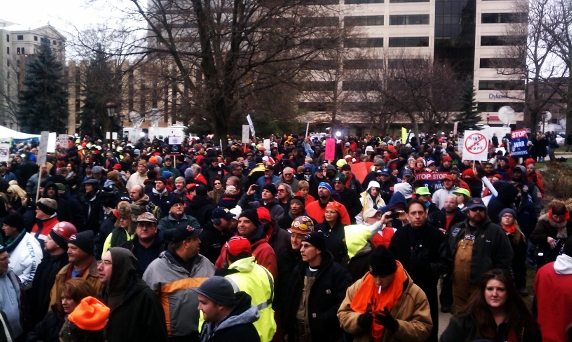
I arrived at the capitol in Lansing at about 9:30 in the morning. The official union-led march was already on the way. Radio broadcasts had consistently estimated their numbers at 5,000 people. The front steps to Michigan’s capitol building were already decorated with pro-labor signs and supporters from the statue of Austin Blair, Michigan’s governor from 1861-1865, to the steps up to the door. The very door of the seat of public representation for the Michigan people shut for the second time while these bills were being debated. The temperature was a little below freezing with a nip of wind, but the weather didn’t sway the stoic crowd or soften their chants.
An auto-worker and UAW member told me about his day thus far. It included a walk through the capitol building during the early hours of the morning before the demonstration began building numbers. The police cited a “capacity” issue about an hour before my arrival and barricaded the only unlocked entrances with waist high fencing and state troopers. On the capitol grounds were several tents and tables for various union locals. Some had literature. Others had hotdogs, various snacks, and coffee to fuel the demonstrators. One huge tent stood off by itself – not too far from the Capitol building yet distanced enough from the other temporary structures. This tent was erected by the only group supporting the Right to Work legislation, the Koch Brothers’ Americans for Prosperity. They were not very welcome on a day that was rather decisive for the state with the 4th largest union density in the country.
The front of the capitol would feature a majority of the days’ outside events. On the sidewalk facing the street were four large inflatable rats wearing labels of various politicians responsible for these bills. They were a popular choice for photo opportunities and midday venting. Across the street stood the state office building, where Gov. Snyder’s office is located. A podium and stage sat diagonal to the rats as an entrance to both the march and downtown Lansing. Then the demonstration suddenly swelled in numbers. A popular estimate was that the demonstration broke 10,000-15,000 people at its peak. News reports would conclude that it reached approximately 13k including the people inside the capitol.
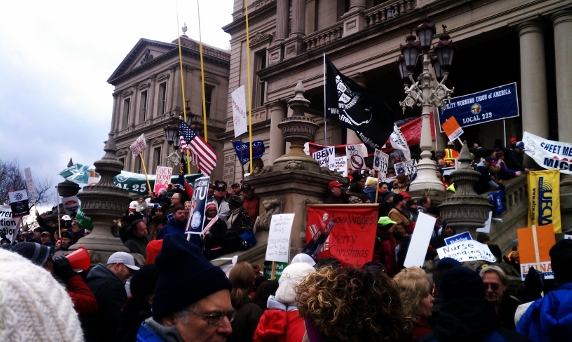
A flurry of snowflakes fell from sky as the capitol’s crowd went from active to almost uncomfortably shoulder-to-shoulder. I handed out copies of Labor Notes to the arriving crowd and had short conversations. People expressed anger over the extremely rushed process of this legislation. For example no hearings had been allowed. Speakers from the stage were praising turnout and thanking supporters. However, the workers on the ground had some more radical tones in their observations. Several criticized the injustice of the system and I recall one rich conversation with two brothers who talked of needed a drastic change in the way we interact politically in this country.
The attitude of rank-and-file union members and non-union supporters began to transform from excited to anxious. Perhaps it was the feeling of gloom as the ominous capitol building overlooked the waves of labor and social justice groups. Or perhaps it was the increasing tension between the locked doors of “democracy” and silenced voices of the people. Reasons aside, the feelings boiled over into physical frustration. I was talking to a member of the Michigan Educator’s Association when a loud set of jeers echoed from the side. A large group of angry union members and supporters had gathered around the tent housing Americans for Prosperity. The chant of “Kill that bill!” turned into “Kill that tent!” (then into another, more vulgar variation of which you could probably guess). Chanting quickly turned to action as the largest tent on the capitol grounds began to sway, first from the outside then the inside. I saw several folks run out of it, but I am unsure if it was populated by right-to-work supporters or not. There were verbal arguments off to the side and, though I couldn’t make out the conversation over the yelling, it was clear they disagreed. I would later find out that a Fox News contributor fell into physical altercations with some protesters. The structure soon came to a crash as the crowd wildly cheered. Some rushed into the fallen debris, tearing up anti-union literature and signs. Police eventually dispersed the situation, but not until the tent and its contents were near obliterated and littering the ground.
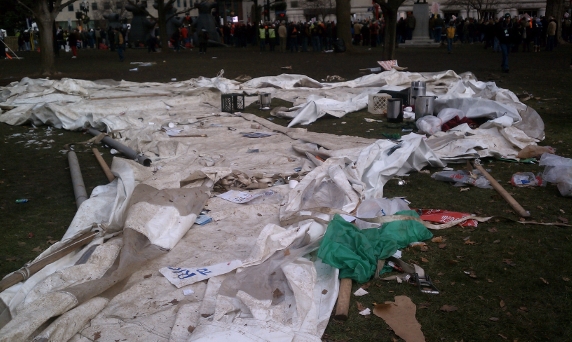
After lunch, police began to let more people into the capitol. I jumped at the opportunity to enter the building which was the epicenter of so much emotion. The rotunda was packed with people and the authorities inside were attempting to shuffle people upstairs. There was no second floor view as hundreds of protesters made their way around the building. The third floor finally enabled me to see the source of commotion on the ground level: about one hundred protesters sitting in around make-shift banners and signs (all outside signs were confiscated during entry). Around them stood even more fellow demonstrators and a thin line of police, who were refusing entry to all but personnel. My neighbor did a quick count of one layer to estimate the ground level crowd was about two hundred in total.
Rallying chants and energy last for only about an hour. The previously mentioned neighbor and I chatted about the day as the sit-in protesters held a mic check and small group meetings. They came to a decision and addressed the onlookers on the overlooking floors. Unfortunately, the speaker was barely audible as the group filed out of the room and building. Deciding to follow them, I said good-bye to my new friend as she noted my cap and replied, “keep up the fight, troublemaker.”
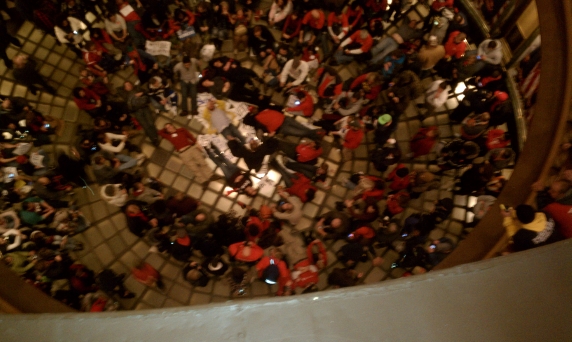
The crowd outside had significantly subsided. Lansing’s capitol grounds consisted of abandoned signs and literature. There were no more speakers on the stage. Instead their voices were replaced by a faint recording of Woody Guthrie’s “Union Maid.” While the demonstration still had hundreds present, the only chants came from a group of people who had maintained a presence around the State Office building where supposedly Governor Snyder was residing.
At the end of the day, the two bills, one aimed at public sector workers and one for the private sector, had passed the House and Senate. But Snyder waited until dark, when the buses had left, to sign it and announce that it was time for Michigan to move on. Unfortunately, it will be difficult for union workers to simply “move on” from what happened on Tuesday.
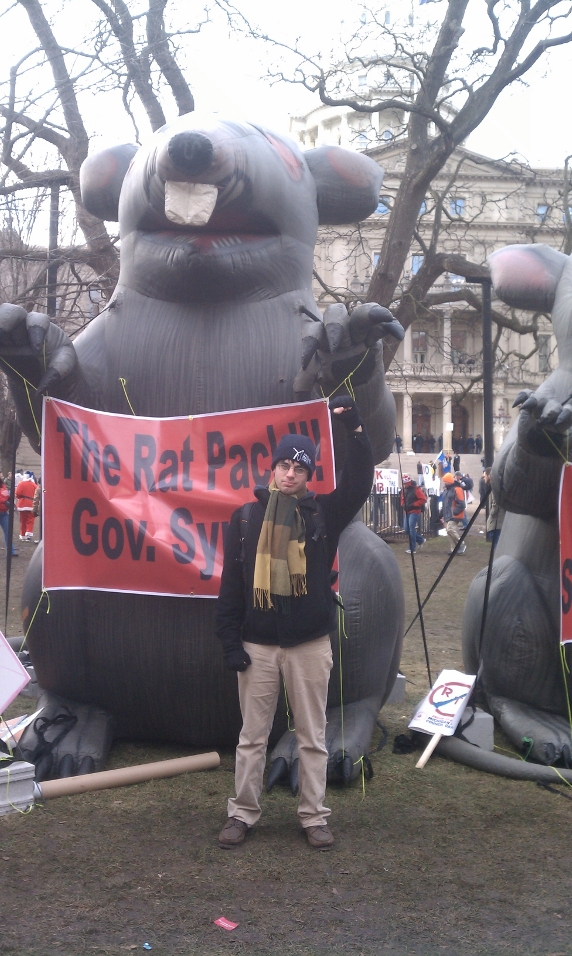
Andy is a national organizer for Solidarity. He currently lives in Detroit.

Comments
2 responses to “The Right to Work for Less: Showdown in Lansing”
The concept of a union is to promote a collective approach by workers, who have common interests that are different from the interests of the corporation. It binds together workers of different “races” and ethnicities, genders, generations. RTW laws attempt to destroy the solidarity among workers at the base.
The legislation allows workers the individual “freedom” not to pay a fee for the representation they receive in union shops. The way to fight the legislation is by continuing the struggle for a democratic and militant union movement. It was great that Jesse Jackson called for Michiganders to start with a one-day strike, and significant that Bob King and Jimmy Hoffa confined their remarks to threatening legal action and a campaign to turn the RTW folks out of office in 2014.
Of course in Michigan the legislature combines RTW laws for both public and private sector unions (exempting only police and firefighters), with Emergency Manager legislation. Although Michiganders just voted it down in the November election, it was passed (offering four “options” instead of one) in the flurry of legislation in the same lame duck session. When utilized, EM legislation provides municipalities and school districts with the tools to tear up contracts, lay off workers and outsource work.
EM and RTW legislation are both attacks the working class!
Thanks for the invigorating report, Andy! As a Michigander in exile, I’m dismayed to see this right-wing surprise attack on unions (not to mention the frightening attack on women’s reproductive rights!) but inspired by the fightback.
I do want to make one clarifying point. Unlike the law Scott Walker passed in Wisconsin, which took away public sector workers’ bargaining rights, a “right to work” law does not affect collective bargaining rights. Right to work impedes dues collection. Without a right to work law, unions are allowed to have contracts which require all workers in a bargaining unit to pay the portion of dues which cover the cost of representing them, regardless of whether they choose to be in the union or not. Right-to-work laws ban such contracts, creating a “free rider” problem (where workers get the benefits of union representation without paying for it) which puts a financial strain on unions. This is why most right to work states have lower union densities.
I’m of two minds about this. On the one hand, it seems like right to work shouldn’t matter. A democratic, fighting union ought to be able to motivate enough of the workers it represents to pay dues, and unions shouldn’t need such huge, expensive bureaucracies. In some cities, like Las Vegas, intrepid unions have built strength in spite of right to work laws. On the other hand, as much as we might want unions that could withstand right to work, in actuality for right to work to stand in Michigan would symbolize another demoralizing defeat for the working class in the Midwest. And strategically, it would be a major blow to the UAW’s efforts to unionize the auto plants in the South (however inadequate that might be) as now the union will have to focus on shoring up dues in its home bases rather than organizing new members.
What are other folks’ thoughts on how radicals who have a vision of a different kind of labor movement should talk about the contradictory issues surrounding right to work?
-Nick D. (Baltimore)